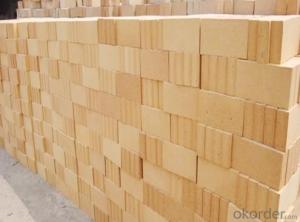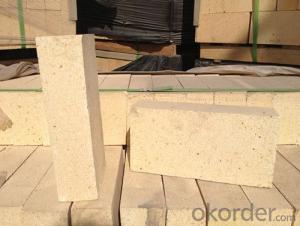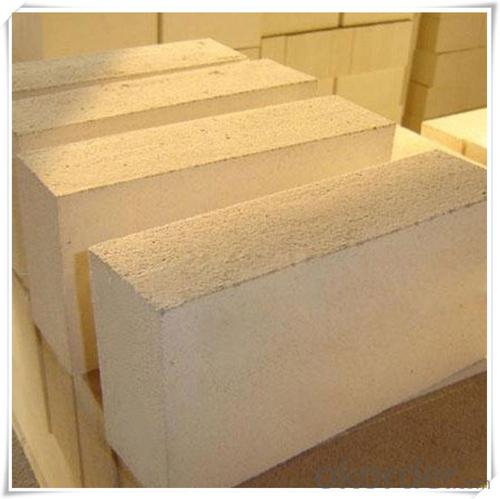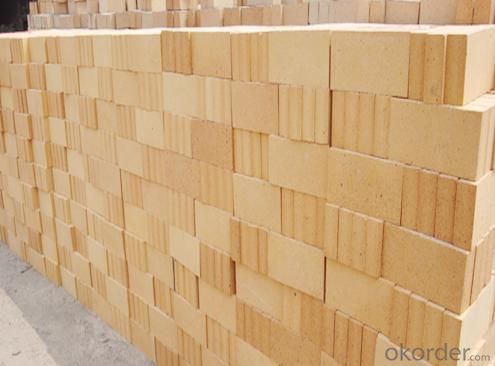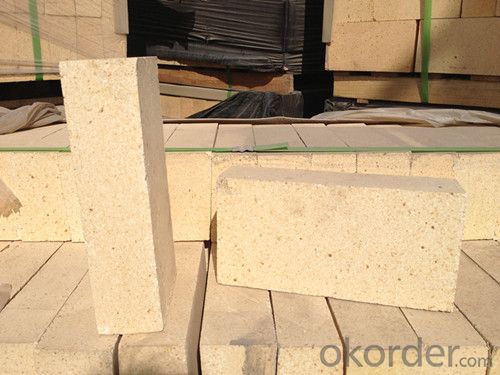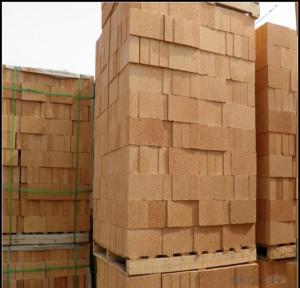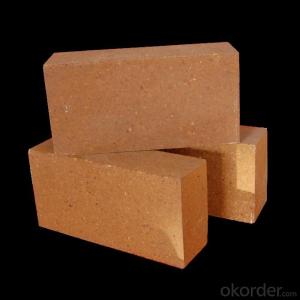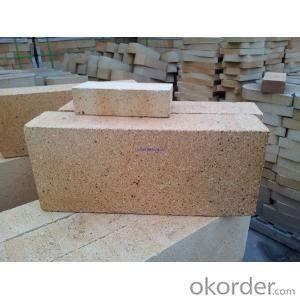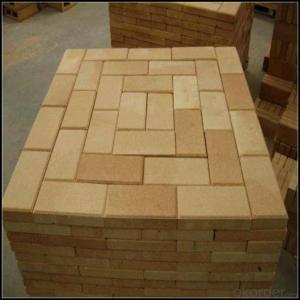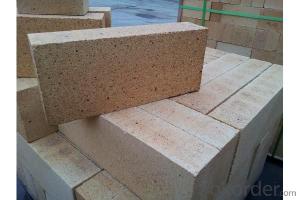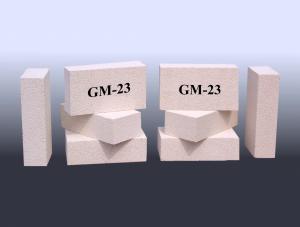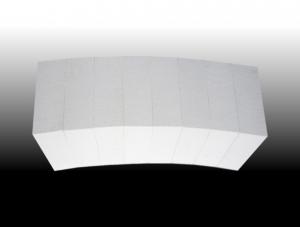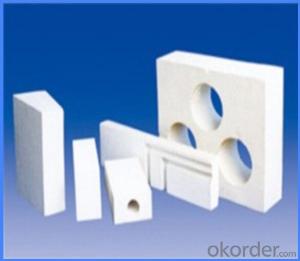Insulating Fire Brick for Steel, Cement, and Glass Industries
- Loading Port:
- Tianjin
- Payment Terms:
- TT OR LC
- Min Order Qty:
- 30 m.t.
- Supply Capability:
- 10000 m.t./month
OKorder Service Pledge
OKorder Financial Service
You Might Also Like
CNBM conforms strictly to the requirements of ISO 9000 quality control system during the production. MSDS is also available if you want. The thermal insulation fire clay brick meet with the requirements of ASTM & JIS standards. So pls stay cool with our quality.
Brief discription for Alumina Fire Brick
CNBM Alumina Fire Brick are classified according to alumina content ranging from 48% to 90%.
CNBM Alumina Fire Brick are commonly used in blast furnace, hot blast furnace, the roof of electric furnace, teeming ladle, rotary kiln, regenerator, etc.
Brief features for Alumina Fire Brick
◆Low thermal conductivity
◆Excellent acid and base slagging resistance
◆High refractoriness
◆Excellent thermal shock resistance
◆Excellent mechanical strength
◆Good spalling resistance and wear resistance.
◆Good corrosion resistance.
◆High-temperature creep rate is quite low.
◆Good volume stability at high temperature.
◆Low bulk density, low thermal conductivity, good thermal insulation performance.
Technical data for high aluminia bricks
ITEM | UAL48 | UAL55 | UAL65 | UAL75 | UAL80 | UAL85 | ALP80 |
Refractoriness, ℃ | 1750 | 1770 | 1790 | 1790 | 1810 | 1810 | 1810 |
Apparent Porosity,% | 22 | 22 | 23 | 23 | 20 | 20 | 18 |
C.C.S, Mpa | 39 | 44 | 49 | 53 | 55 | 60 | 100 |
Refractories Under Load (0.2Mpa),℃ | 1420 | 1470 | 1500 | 1520 | 1500 | 1520 | 1550 |
Reheating Linear Change,% | 1450℃x2h 0.1~-0.4 | 1500℃x2h 0.1~-0.4 | 1500℃x2h 0.1~-0.4 | 1500℃x2h 0.1~-0.4 | 1550℃x2h -0.5~+0.5 | 1550℃x2h -0.5~+0.5 | 1550℃x2h -0.5~+0.5 |
Al2O3 Content , % | 48 | 55 | 65 | 75 | 80 | 85 | 82 |
Why us
Professional fire brick manufacturer. We have being specialized in producing refractory fireclay brick for more than 40 years so that we can guarantee a stable quality.
Guaranteed quality. Our production process conforms strictly to the requirements of ISO9000 quality management system. Quality inspection is carried out in every links of our production. SGS third party inspection is available.
Sound after sales service. We provide sound after sales service. We provide 24 hours’ consultation service. We are ready to answer your consultations at any time.
- Q: Can insulating fire bricks be used in the construction of ladles?
- Yes, insulating fire bricks can be used in the construction of ladles. These bricks are designed to withstand high temperatures and provide excellent thermal insulation. They are commonly used in industrial applications such as ladle lining to maintain heat and prevent heat loss, ensuring efficient and safe operations in metal casting and foundry processes.
- Q: Can insulating fire bricks be used in residential applications?
- Yes, insulating fire bricks can be used in residential applications. They are commonly used in residential fireplaces, wood-burning stoves, and pizza ovens to provide insulation and increase energy efficiency. Their high heat resistance and insulating properties make them suitable for these applications.
- Q: Can insulating fire bricks be used for insulation in glass manufacturing?
- Yes, insulating fire bricks can be used for insulation in glass manufacturing. Insulating fire bricks are designed to have excellent thermal insulation properties, high heat resistance, and low thermal conductivity. These characteristics make them suitable for applications where high temperatures need to be maintained or controlled, such as in glass manufacturing processes. The use of insulating fire bricks in glass manufacturing helps to reduce heat loss and improve energy efficiency. By insulating the furnace or kiln, the bricks prevent excessive heat from escaping, thereby reducing the energy required to maintain the desired temperature. This not only saves on energy costs but also helps to create a more stable and controlled environment for the glass manufacturing process. Furthermore, insulating fire bricks can withstand the extreme temperatures typically involved in glass manufacturing, making them a reliable choice for insulation. They can withstand temperatures up to 3000 degrees Fahrenheit (1650 degrees Celsius), ensuring the bricks remain structurally intact and effective in insulating the furnace or kiln. In summary, insulating fire bricks are a suitable choice for insulation in glass manufacturing due to their excellent thermal insulation properties, high heat resistance, and low thermal conductivity. They help to improve energy efficiency, maintain stable temperatures, and create a controlled environment for the glass manufacturing process.
- Q: Can insulating fire bricks be used for insulation in sewage treatment plants?
- Insulating fire bricks are capable of being utilized for insulation purposes in sewage treatment plants. Specifically designed to endure elevated temperatures and deliver exceptional insulation, these bricks prove to be suitable for deployment in environments characterized by heat and moisture, such as sewage treatment plants. With their low thermal conductivity, they aid in diminishing heat loss and enhancing energy efficiency throughout the treatment procedure. Furthermore, their resistance to chemicals and moisture renders them ideal for enduring the corrosive surroundings typically encountered in sewage treatment plants. Consequently, the usage of insulating fire bricks effectively ensures insulation in sewage treatment plants, thereby aiding in the preservation of optimal operating temperatures and the enhancement of overall efficiency.
- Q: What is the recommended curing method for insulating fire bricks?
- To prevent cracking or damage, it is advised to gradually and carefully air dry insulating fire bricks after they have been laid and mortared into place. It is crucial to maintain a stable temperature and humidity level throughout the curing process. This can be achieved by gradually increasing the temperature over a few days and ensuring proper ventilation. The bricks should be exposed to air circulation to aid in the evaporation of any moisture in the mortar or within the bricks themselves. It should be noted that the length of the curing process may vary depending on the size and thickness of the brickwork. Attempting to expedite the process by applying excessive heat or moisture can cause thermal stress and compromise the integrity of the bricks. In some instances, it may be advisable to pre-fire the bricks in a kiln to eliminate any remaining moisture before installation. This can help accelerate the curing process and guarantee that the bricks are completely dried before being put into service. In conclusion, the recommended curing method for insulating fire bricks involves gradual air drying, maintaining consistent temperature and humidity levels, and allowing sufficient time for the bricks to fully cure before exposing them to high temperatures. By adhering to these guidelines, the longevity and performance of the insulating fire bricks can be ensured.
- Q: Can insulating fire bricks be used in the construction of ladles?
- Insulating fire bricks are indeed suitable for ladle construction. These bricks are crafted from lightweight materials that possess exceptional thermal insulation properties. As a result, they are well-suited for situations where heat retention or control is paramount, such as in the creation of ladles for metal or glass industries. By utilizing insulating fire bricks, heat loss can be minimized, energy efficiency can be enhanced, and the desired temperature within the ladle can be maintained. Furthermore, their lightweight composition facilitates easier handling and installation during ladle construction. Consequently, insulating fire bricks are a viable choice for ladle construction, as they furnish the necessary thermal insulation and durability requisite for these high-temperature applications.
- Q: Can insulating fire bricks be used in the construction of ceramic fiber kilns?
- Yes, insulating fire bricks can be used in the construction of ceramic fiber kilns. Insulating fire bricks provide excellent thermal insulation, which helps to retain heat and improve energy efficiency in kilns. They are often used as the lining material in kilns to prevent heat loss and ensure efficient firing processes.
- Q: There are several construction techniques for exterior wall insulation
- Exterior wall sandwich insulation technologyThe exterior wall sandwich insulation is to place the heat preservation material between the inner and outer wall sheets of the outer wall, and the inner and outer walls can be made of concrete hollow blocks.Advantage:1) to the inner wall piece and the heat preservation material forms the effective protection, to the heat preservation material selection material request is not high (source: Chinese heat preservation net), polystyrene, glass cotton and urea aldehyde field casting material and so on may use;2) the construction season and construction conditions are not very high, and it does not affect the winter construction. In Heilongjiang, Inner Mongolia, northern Gansu and other cold areas have been given some applications.Shortcoming:1) in non cold areas, this kind of wall is thicker than traditional wall;2) the inner and the outer wall pieces need to be connected by connecting pieces, and the structure is more complicated than the traditional wall;3) periphery structure of "bridge" more. In the earthquake zone, building circle beam and constructional column settings, "bridge" more efficiency of thermal insulation materials is still not fully play.4) outside the walls by the outdoor climate, the temperature difference between day and night and the large temperature difference between summer and winter, easy to cause the wall cracking and leakage of rainwater.
- Q: Are insulating fire bricks suitable for insulation in cryogenic applications?
- Yes, insulating fire bricks are suitable for insulation in cryogenic applications. Insulating fire bricks are made from lightweight refractory materials that have excellent thermal insulation properties. They have low thermal conductivity, high melting points, and are able to withstand extremely low temperatures, making them ideal for cryogenic applications. Cryogenic applications involve handling and storing materials at very low temperatures, typically below -150 degrees Celsius (-238 degrees Fahrenheit). Insulating fire bricks are designed to provide effective insulation in such extreme temperatures, preventing heat transfer and maintaining the desired low temperature. Furthermore, insulating fire bricks are chemically stable and have good resistance to thermal shock, meaning they can withstand rapid temperature changes without cracking or deteriorating. This is particularly important in cryogenic applications where temperature fluctuations are common. In addition to their excellent thermal insulation properties, insulating fire bricks are also lightweight and easy to handle, making them convenient for installation in cryogenic systems. Overall, insulating fire bricks are a suitable choice for insulation in cryogenic applications due to their thermal insulation properties, high-temperature resistance, chemical stability, and resistance to thermal shock.
- Q: Are insulating fire bricks resistant to insects and rodents?
- No, insulating fire bricks are not specifically designed to be resistant to insects and rodents. While these bricks are primarily used for their excellent thermal insulation properties in high-temperature applications such as furnaces and kilns, they do not possess any inherent resistance to pests. If you are concerned about insects or rodents, it is recommended to implement additional pest control measures such as sealing any gaps or cracks and using appropriate pest deterrents.
Send your message to us
Insulating Fire Brick for Steel, Cement, and Glass Industries
- Loading Port:
- Tianjin
- Payment Terms:
- TT OR LC
- Min Order Qty:
- 30 m.t.
- Supply Capability:
- 10000 m.t./month
OKorder Service Pledge
OKorder Financial Service
Similar products
Hot products
Hot Searches
Related keywords

